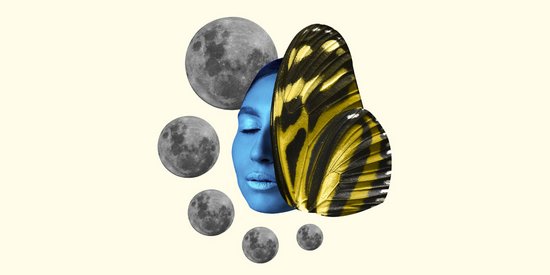Practicing N.L.P. means giving yourself the means to feel the wonderful sensation of being, that makes you want to exclaim: "I am". And, for that, there is no need to force yourself into difficult exercises, to experience deprivation or to devote your whole life to it.
But first, what does N.L.P. stand for?
N.L.P is the abbreviation of "Neuro-Linguistic Programming".
Neuro: means these automatisms are "engrained" in our brain.
Linguistic: means that this programming is expressed through our verbal and non-verbal language (our conscious and subconscious behaviors).
Programming: refers to our upbringing and past experiences. Due to this education and these past experiences, we are programmed to reproduce certain behavior, have certain habits, certain automatisms ...
N.L.P. is therefore an effective communication tool and constitutes of a set of mental techniques, allowing the development of the potential of each person. Spiritual NLP will also take the spiritual dimension into account and be based on three fundamental principles: the quest for love, consciousness and a sense of responsibility, in order to establish a harmonious connection between heart and reason.
Origins of NLP
N.L.P. originated in the 1970s from the work of two people: John Grinder and Richard Bandler.
3 renowned practitioners are representative of this approach.
They are: Fritz Perls: neuropsychiatrist and psychoanalyst who also created gestalt therapy, Virginia Satir: the mother of family therapy, Milton Erickson: a famous American psychiatrist and hypnotherapist. NLP is also influenced by many approaches from the Palo Alto School:
• Cybernetics
• The systemic approach
• Constructivism
• Anthropological.
• General semantics
• Transformational grammar
In 1972, at the University of Santa Cruz, California, Richard Bandler, psychologist, and John Grinder, linguist, got together to meet and pool their knowledge and experiences, to work out what would eventually become NLP. They then worked on the theme of "excellence" in communication and explored different types of situations to identify their common characteristics. They assumed that it is possible to maintain the characteristics that produce "excellence" in all kinds of different situations of communication. For Grinder and Bandler, "excellence" was measured by the result obtained, its suitability for the desired objective and the economy of the means employed. Psychotherapy soon became their main field of investigation, because it allowed them to produce major behavioral changes. They then measured "excellence" according to the achievement of clearly defined objectives and the speed of the results.
Through careful observation of numerous recorded sessions, they managed to highlight consistent elements in any effective communication situation.
They thus set up models of effectiveness to be applied to psychotherapy and personal development, but also to very different contexts such as parental relationships, education, teaching, sales ...
NLP thus transformed rapidly at the same time as it encountered cultures other than its original culture and other subjective disciplines. Today, NLP models are used in conjunction with:
• spiritual disciplines such as Buddhism and shamanism
• energy systems like acupuncture and the chakras
• organisational methods such as management
• healing techniques like energy healing and clairvoyance
Simultaneously with this revolution, NLP was re-anchored in its origins:
• Hypnosis
• General semantics
• Phenomenology …
Principles
NLP has presuppositions that support any practice. These are:
• "The map is not the territory"
• There is an irreducible difference between an alleged reality and an organism's experience of that reality.
• Each person has their own map of the world - the development of which is determined by their morphogenesis and personal history.
• No model of the world is more "true" or "real" than another.
• More than by territory or "reality", an individual's choices are limited by their own model of the world and the possible responses they know to give.
• Models giving access to greater choices, or to richer choices, can be fruitful.
• Everyone builds their own model of the world through their nervous system
• Neurological patterns consist of inputs and are stored through our representation systems of representation (VAKOG = Visual, Auditory, Kinesthetic, Olfactory and Gustatory).
• Knowledge, meaning, thoughts, etc. are the result of internal computations which consist of overlaps (synesthesias), correlations (behavioral equivalences) and connections (associations) between systems of representations.
"Mind and body form a cybernetic system"
• For each neurological pattern, there is a co-occurring behavioral manifestation and vice versa
• We adjust the value of the information signal in our systems of representation through behavioral alterations or ocular access.
• Neurological programs operate as feedback loops (TOTE) rather than linear reflex arcs of stimulus-responses
• Behavior is more goal oriented rather than stimulus driven
• A pattern of association can be established by a single experiment in contrast to a linear repetition
• There is a deep "neuro-linguistic" interaction between language and our neurological models of the world.
• Individual abilities are a function of the development and sequencing of the systems of representation
Consciousness is a limited phenomenon:
• Individuals can maintain seven plus, or minus two "pieces" of information in their consciousness at any time (average memory capacity)
• The type of element will determine how an experiment is punctuated
• Coding congruence, that is to say that the same chains of behavior will be reproduced and thus become more automatic
• Biological interactions are systemic (cybernetic) rather than being linear
• Human interactions form cybernetic systems, that is to say they are in perpetual interaction
• Cybernetic systems are adaptation oriented.
• Cybernetic systems are organized into different logical levels of structure
• The rules for changing and strengthening one level will not be the same as for another level. What is positive at one level may be negative at another level
• People make the best choices possible for themselves, taking into account the possibilities and abilities that they perceive to be available to them from their model of the world.
• The law of required variety: the part of the system which presents the most flexibility will be the element of catalyst.
• Effective behaviors are organized in TOTE (Test-Operation-Test-Exit) that is to say they have a fixed objective and characterize the means to achieve the objective.








